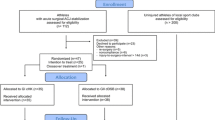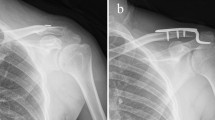Abstract
Objectives
To investigate the association between distal clavicular osteolysis (DCO) and bench pressing intensity.
Methods
From a retrospective review of MRI shoulder reports of individuals between 20 and 40 years of age, 262 male patients with DCO and 227 age-matched male patients without DCO were selected. All patients had completed a bench pressing questionnaire. The patients’ bench pressing frequency (times per week), duration (years of bench pressing), bench pressing weight (maximum bench pressing weight with one repetition = 1RM) and the ratio of bench pressing weight to body weight were compared between both groups using Chi-square and Mann–Whitney tests.
Results
The results showed that 56 % (146/262) of patients with DCO were high-intensity bench pressers (1RM more than 1.5 times the body weight) compared to 6 % (14/227) in patients without DCO. High-intensity bench pressing was a risk factor for DCO (OR = 19; 95 %CI = 11–35; p < 0.001). Low-intensity bench pressing (1RM less than 1.5 times the body weight) was not a risk factor for DCO (OR = 0.6; 95 % CI = 0.4–0.8). High frequency (>1×/week) and duration (>5 years) of bench pressing were risk factors. In bench pressers who suffered from DCO, the mean 1RM was 283 lbs (±SD 57) compared to 209 lbs (±SD 60) in bench pressers not affected by DCO (p < 0.001, Mann–Whitney).
Conclusions
High-intensity, but not low-intensity bench pressing is a risk factor for DCO.

Similar content being viewed by others
References
Sports and Fitness Industry Association. Press release. https://www.sfia.org/press/632. Accessed 12 Sept 2015.
Kerr ZY, Collins CL, Comstock RD. Epidemiology of weight training-related injuries presenting to United States emergency departments, 1990 to 2007. Am J Sports Med. 2010;38:765–71. doi:10.1177/0363546509351560.
Kolber MJ, Beekhuizen KS, Cheng MS, Hellman MA. Shoulder injuries attributed to resistance training: a brief review. J Strength Cond Res. 2010;24:1696–704. doi:10.1519/JSC.0b013e3181dc4330.
Yu JS, Habib PA. Common injuries related to weightlifting: MR imaging perspective. Semin Musculoskelet Radiol. 2005;9:289–301. doi:10.1055/s-2005-923375.
Mair SD, Zarzour RH, Speer KP. Posterior labral injury in contact athletes. Am J Sports Med. 1998;26:753–8.
de Castro Pochini A, Andreoli CV, Belangero PS, et al. Clinical considerations for the surgical treatment of pectoralis major muscle ruptures based on 60 cases: a prospective study and literature review. Am J Sports Med. 2014;42:95–102. doi:10.1177/0363546513506556.
Bhatia DN, de Beer JF, van Rooyen KS, Lam F, du Toit DF. The “bench-presser’s shoulder”: an overuse insertional tendinopathy of the pectoralis minor muscle. Br J Sports Med. 2007;41:e11. doi:10.1136/bjsm.2006.032383.
Finnoff JT, Thompson JM, Collins M, Dahm D. Subcoracoid bursitis as an unusual cause of painful anterior shoulder snapping in a weight lifter. Am J Sports Med. 2010;38:1687–92. doi:10.1177/0363546510381546.
Lavallee ME, Balam T. An overview of strength training injuries: acute and chronic. Curr Sports Med Rep. 2010;9:307–13. doi:10.1249/JSR.0b013e3181f3ed6d.
Cahill BR. Atraumatic osteolysis of the distal clavicle. Rev Sports Med. 1992;13:214–22. doi:10.2165/00007256-199213030-00005.
Cahill BR. Osteolysis of the distal part of the clavicle in male athletes. J Bone Joint Surg Am. 1982;64:1053–8.
Roedl JB, Nevalainen M, Gonzalez FM, Dodson CC, Morrison WB, Zoga AC. Frequency, imaging findings, risk factors, and long-term sequelae of distal clavicular osteolysis in young patients. Skelet Radiol. 2015;44:659–66.
Kassarjian A, Llopis E, Palmer WE. Distal clavicular osteolysis: MR evidence for subchondral fracture. Skelet Radiol. 2007;36:17–22. doi:10.1007/s00256-006-0209-y.
Brzycki M. A practical approach to strength training. McGraw-Hill; 1998. ISBN 1-57028-018-5.
ExRx.net. Exercise prescription on the internet. Fitness testing. Calculators. Fitness. http://www.exrx.net/Calculators/OneRepMax.html. Accessed 12 Sept 2015.
Haupt HA. Upper extremity injuries associated with strength training. Clin Sports Med. 2001;20:481–90. doi:10.1016/S0278-5919(05)70264-7.
Roedl JB, Morrison WB, Ciccotti MG, Zoga AC. Acromial apophysiolysis: superior shoulder pain and acromial nonfusion in the young throwing athlete. Radiology. 2015;274:201–9.
Fees M, Decker T, Snyder-Mackler L, Axe MJ. Upper extremity weight-training modifications for the injured athlete. A clinical perspective. Am J Sports Med. 1998;26(5):732–42.
Charron KM, Schepsis AA, Voloshin I. Arthroscopic distal clavicle resection in athletes: a prospective comparison of the direct and indirect approach. Am J Sports Med. 2007;35:53–8. doi:10.1177/0363546506294855.
Author information
Authors and Affiliations
Corresponding author
Ethics declarations
Conflict of interest
The authors declare that they have no conflicts of interest.
Ethical approval
All procedures performed in studies involving human participants were in accordance with the ethical standards of the institutional and/or national research committee and with the 1964 Helsinki Declaration and its later amendments or comparable ethical standards.
Informed consent
Institutional review board approval was obtained and the requirement for informed consent was waived.
Rights and permissions
About this article
Cite this article
Nevalainen, M.T., Ciccotti, M.G., Morrison, W.B. et al. Distal clavicular osteolysis in adults: association with bench pressing intensity. Skeletal Radiol 45, 1473–1479 (2016). https://doi.org/10.1007/s00256-016-2446-z
Received:
Revised:
Accepted:
Published:
Issue Date:
DOI: https://doi.org/10.1007/s00256-016-2446-z




